
We are celebrating 15 years — and counting — of stories that are deeply researched and deeply felt, that build a historical record of what the city has been.
We are celebrating 15 years — and counting — of stories that are deeply researched and deeply felt, that build a historical record of what the city has been.
Today marks a milestone for us: five years ago, Urban Omnibus went live. Since January 7, 2009, we have published hundreds of stories, profiles, projects, interviews, reports, and explorations in the pursuit of defining and enriching what we call the culture of citymaking. As this collection of content has grown over time, the site has evolved into a rich resource for anyone interested in the people, policies, and projects that shape the physical form and experience of place in the five boroughs. Our hope is that highlighting exemplary ideas for a better urban future for New York will encourage sophisticated urban practice for cities worldwide.
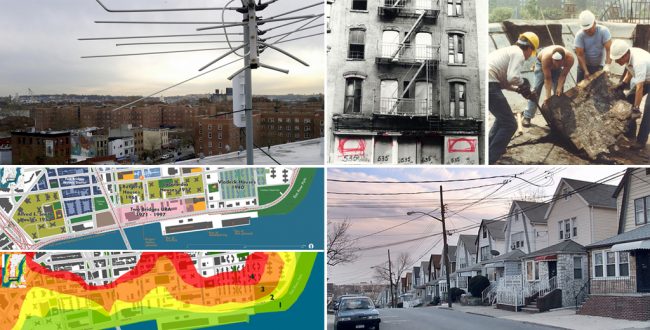
Act Local | Local Connections: The Red Hook WiFi Project, Self-Help Housing: The Story of the Urban Homesteading Assistance Board, Making Connections: Planning for Green Infrastructure in Two Bridges, and Bringing Basements to Code
When we conceived of Urban Omnibus, we defined eight recurring series that would serve as portals into the work and ideas that we would explore. Act Local would spotlight innovative projects and organizations whose field of action is a particular patch of New York, in order to collect perspectives on how locally based initiatives affect the design and building of the city. Make It Visible would showcase original strategies in communicating and explicating complex or hidden urban conditions and processes. Sites + Projects would concentrate on the specific architectural application of ideas and strategies covered on Urban Omnibus, through profiles of interdisciplinary physical interventions in the city’s fabric. Unseen Machine would expose the technologies that keep the city running day to day and introduce the characters and designs involved in maintaining, managing, and re-imagining the systems that make New York work. Vanguard would illuminate groundbreaking new technologies and ideas and examine the design process behind their development. Walks and Talks would introduce figures, both well known and unrecognized, involved in the design, building, and “thinking” of the city — informally and in their own words — ranging from city commissioners to architects to community activists to artists. Writing the City would envision New York City through written reflection and opinion. And our Forum would offer a space for shorter, news-based posts, such as recaps and reviews of lectures, exhibitions, books, and conferences, suggestions of field trips and explorations out in the physical city, opinion pieces, artists’ portfolios, and updates on events and opportunities of interest to our audience.
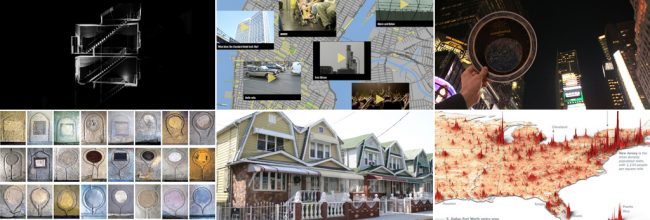
Make It Visible | Lead Pencil Studio: Looking at Nothing, MyBlockNYC, The City Dark, Urban Topographies: Cuts & Patches, The Brooklyn Typology Project, and Let’s Talk About Maps
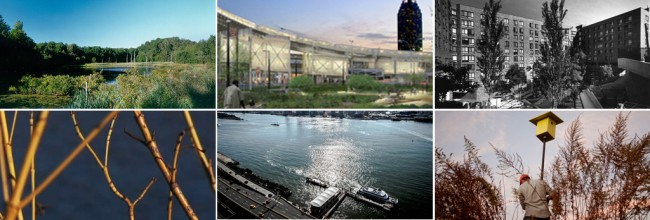
Sites + Projects | The Staten Island Bluebelt: Storm Sewers, Wetlands, Waterways, Queens Plaza: Infrastructure Reframed, The Landscape of Housing: Twin Parks Northwest 40 Years On, George Trakas at the Water’s Edge: Newtown Creek, Multitasking Infrastructures: A Conversation with Sheila Kennedy and Veit Kugel, and Canal Nest Colony
We quickly learned these categories were only a start. Over the past five years, themes emerged in our archive, connections between pieces of content we didn’t expect to find, and those threads reveal, in part, the story of the needs, desires, and priorities of the city at a particular moment in time.
Stories about flexible workspaces, shared vehicles, energy generation prototypes, and unexpected performance venues demonstrate a desire to make the most of the city’s underutilized spaces and maximize existing resources. An early interest in surfacing the untapped energy and ideas generated in schools and workshops led to a series of Studio Reports, which, so far, have investigated housing, aging in place, productive ecologies, mapping, and capacity creation through landfill. And our enthusiasm for compelling photography and visual representation has led us from changing neighborhoods to the city’s sewers, from lights to shadows, from architecture under construction to architecture left abandoned, and from the celebration of a New York City landmark to the dark imagining of the future of real estate.
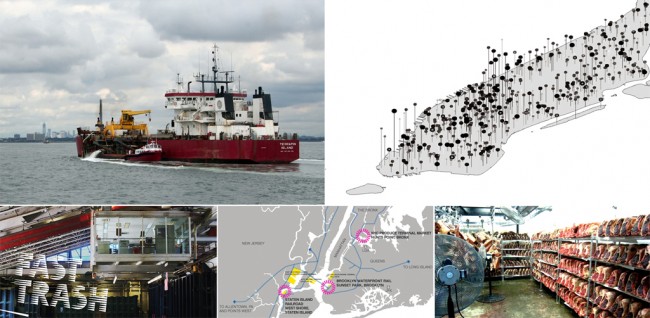
Unseen Machine | A City Built on Dredge, Signal Space, Fast Trash!, Supply Chain Spotlight: Freight Rail, and Food and the Shape of Cities
Some of these themes are predictable. We knew at the outset that transportation, infrastructure, public space, housing, and the city’s relationship with its waterfront and waterways would be of frequent concern to a publication about urban life and landscape. But the ways in which we discussed them was not always so expected. Our initial notions of how we might cover transportation networks expanded to include poetic documentation of industrial processes, the ecology of the city as experienced from the 7 train, and the lasting effects of a 1888 blizzard. Our waterways are not just the domain of freight transport, oyster beds, and the Coast Guard, but also energy conversion initiatives, floating pools, the fire department, and a massive-scale application of complex dredging technologies.
In the coming weeks and months, as we reflect on our first five years and look forward to our next, we will build upon these emerging themes. To start, we will resurface highlights from the archive in a series of Forum posts, looking at how we’ve talked about food, waste, New York City history, multitasking infrastructures, urban exploration, housing, technology, and more. We will then add new voices and ideas to the conversations that have already started, and we will venture into perspectives and projects we have not yet investigated. We will continue our periodic special projects, such as Typecast and our annual writing competition, and expand upon our live events, from meet-ups to parties to occasional salon dinners.
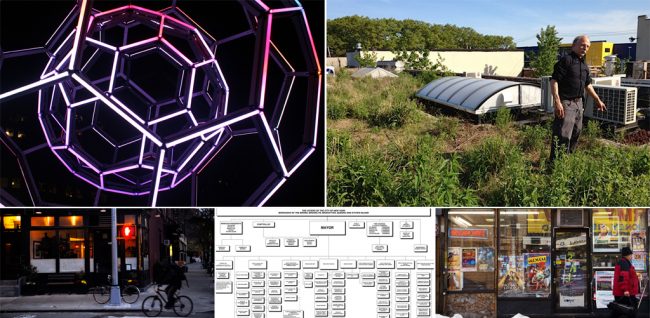
Walks and Talks | Sequence of Light: A Conversation with Leo Villareal, City of Soil: A Walk Down Stratford Avenue with Paul Mankiewicz, A Walk with Richard Sennett, The Underlying Structure: A Conversation on Law with Gerald Frug, A Walk through Jackson Heights with Suketu Mehta
Any anniversary offers a prime opportunity not just for reflection, but also for thinking about what has changed over the years, what role we want to serve moving forward, and how we can aspire to a new set of goals. Over the coming weeks, we will evaluate what has worked and what hasn’t, and we will reach out to our readers for feedback. In the meantime, remember that we are always available at info@urbanomnibus.net and through our submissions page. One of the original intents of Urban Omnibus was to create a space for a wide range of points of view and expertise, and that is a mission we will continue to pursue. We welcome ideas and comments from readers as well as pitches and expressions of interest from writers. If you, too, have a passion for encouraging better understanding of cities and how they work, and for advancing strategies for creating a more equitable, stimulating, beautiful, healthy, and sustainable built environment and lived experience, then we want to hear from you.
Thanks to all of our readers and all of our supporters for an incredible first five years.
The Architectural League of New York, a non-profit organization, works hard to provide the content on Urban Omnibus to its readers for free. Please consider supporting this project by donating or becoming a member of the League today.
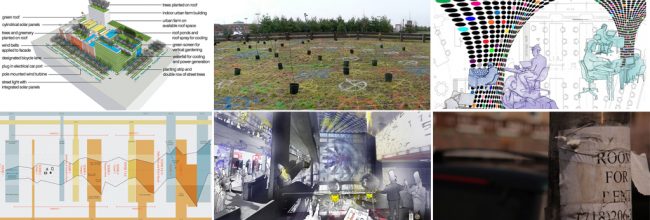
Vanguard | Clip-on Architecture, Experimental Landscapes: Alexander Felson on Ecology and Design, Work and the Open Source City, Odyssey Works: The City for an Audience of One, Air Futures, and Making Room
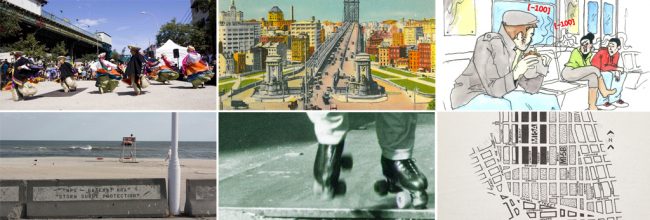
Writing the City | Naturally Occurring Cultural Districts, Flatbush Start to Finish, The City That Never Shouts, Lessons from Rockaway: What to Save from the Flood, Transgressing the Grid: Adventures On (and Off) Manhattan Island, and Living Lofts: The Evolution of the Cast Iron District
Photo on homepage by Flickr user korafotomorgana.
The views expressed here are those of the authors only and do not reflect the position of The Architectural League of New York.